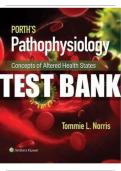, TEST5BANK5FOR5PORTH'S5PATHOPHYSIOLOGY510TH5EDITION5BY5NORRIS
Porth’s Pathophysiology 10th Edition Norris Test Bank
5 5 5 5 5 5
1. At5an5international5nursing5conference,5many5discussions5and5breakout5sessions5focusedo
5n5the5World5Health5Organization5(WHO)5views5on5health.5Of5the5following5commentsm
a5de5by5nurses5during5a5discussionssession,5which5statements5would5be5considered5a5good
5r5epresentation5of5the5WHO5definition? 5Select5all5that5apply.
A) Interests5in5keeping5theselderly5population5engaged5in5such5activities5as5bookr
5eviews5and5word5games5during5social5time
B) Increase5in5the5number5of5chairsaerobics5classes5providedsin5the5skilledscaref
5acilities
C) Interventions5geared5toward5keeping5the5elderly5population5diagnosed5with5diabete
5s5mellitus5under5tight5blood5glucosescontrol5by5providing5in-
home5cookingsclasses
D) Providingstransportation5for5renal5dialysis5patients5to5and5from5their5hemodialysiss
5essions
E) Providingshandwashing5teaching5sessions5to5a5group5of5young5children
5Ans:5A,5B,5C,5E
Feedback:
The5WHO5definition5of5health5is5defined5as5“a5state5of5complete5physical,5mental,5and5soc
5ial5well-
being5and5not5merely5the5absence5of5disease5and5infirmity.”5Engaging5in5book5reviews5fa5
cilitates5mental5and5social5well-being;5chair5aerobics5helps5facilitate5physical5well-
5being;5and5assistingswith5tight5control5of5diabetes5helps5with5facilitatingsphysical5well-
5being5even5though5the5person5has5a5chronic5disease.5Handwashing5is5vitalin5thespreventio
5n5of5disease5and5spreadsof5germs.
2. A5community5health5nurse5is5teaching5a5group5of5recent5graduates5about5the5large5vari
5ety5of5factors5that5influence5an5individual's5healthsor5lack5thereof.5Thesnurse5is5referr
i5ng5to5the5Healthy5People52020sreport5from5the5U.S.5Department5of5Health5andHuma
n5Services5as5a5teaching5example.5Of5the5following5aspects5discussed,5which5would5b
e5c5onsidered5a5determinant5of5health5that5is5outside5the5focus5of5this5report?
A) The5client5has5a5diverse5background5by5being5of5Asian5and5Native5American5des
5cent5and5practices5various5alternative5therapies5to5minimize5effects5of5stress.
B) The5client5has5a5family5history5of5cardiovascular5disease5related5to5hyperchol
5esterolemia5and5remains5noncompliantswith5the5treatment5regime.
C) The5client5has5asgood5careerswith5exceptional5preventative5health5care5benefits.
D) The5client5lives5in5an5affluent,5clean,5suburban5community5with5access5tosmanyh
5ealthscare5facilities.
Ans:5B
Feedback:
In5Healthy5People52020,5the5focus5is5to5promote5goodshealth5to5all5(such5as5using5alternati
5ve5therapies5to5minimize5effects5of5stress);5achieving5health5equity5and5promoting5health5
f5or5all5(which5includes5having5good5health5caresbenefits);5and5promoting5good5health5(w
hi5ch5includes5living5insa5clean5community5with5good5access5tohealthscare).5A5client's5non
co5mpliance5with5treatments5to5control5high5cholesterol5levelswithin5the5presence5of5a5fam
ily5history5of5CV5disease5does5not5meet5the5“attaining5lives5free5of5preventable5disease5an
dspr5emature5death”5determinant.
, TEST5BANK5FOR5PORTH'S5PATHOPHYSIOLOGY510TH5EDITION5BY5NORRIS
3. A5physician5is5providing5care5for5a5number5of5patients5on5a5medical5unit5of5a5large,5univers
5ity5hospital.5The5physician5is5discussing5with5a5colleague5the5differentiation5between5dise
a5ses5that5are5caused5by5abnormal5molecules5and5diseases5that5cause5disease.Which5of5the5
fo5llowing5patients5most5clearly5demonstrates5the5consequences5of5molecules5that5cause5d
ise5ase?
A) A531-year-
old5woman5with5sickle5cell5anemia5who5is5receiving5a5transfusion5ofpacked5red5b
5lood5cells
B) A591-year-
old5woman5who5has5experienced5an5ischemic5stroke5resulting5fromfamilial5hyp
5ercholesterolemia
C) A519-year-
old5man5with5exacerbation5of5his5cystic5fibrosis5requiring5oxygentherapy5and
5chest5physiotherapy
D) A530-year-
old5homeless5manswho5has5Pneumocystis5carinii5pneumonia5(PCP)5andis5HIV5posit
5ive.
Ans:5D
Feedback:
PCP5is5an5example5of5the5effect5of5a5molecule5that5directly5contributes5to5disease.5Sicklece
5ll5anemia,5familial5hypercholesterolemia,5and5cystic5fibrosis5are5all5examples5of5the5effec
t5s5of5abnormal5molecules.
4. A5membersof5the5health5care5team5is5researching5the5etiology5and5pathogenesis5of5a5num
5ber5of5clients5who5are5under5his5care5in5a5hospital5context.5Which5of5the5followingaspec
t5s5of5clients'5situations5bN
esUt R
chSaI
raN
ctGerTizBe.
ssC
paOthMogenesis5rathersthan5etiology?
A) A5clientswho5has5been5exposed5to5the5Mycobacterium5tuberculosis5bacterium
B) A5clientswho5has5increasing5serum5ammonia5levels5due5to5liver5cirrhosis
C) A5clientswho5was5admitted5with5the5effects5of5methyl5alcohol5poisoning
D) A5client5withsmultiple5skeletal5injuries5secondary5to5a5motor5vehicle5accident
5Ans:5B
Feedback:
Pathogenesis5refers5to5the5progressive5and5evolutionary5course5of5disease,5such5as5thei5
ncreasing5ammonia5levels5that5accompany5liver5disease.5Bacteria,5poisons,5and5trauma5t
ic5injuries5are5examples5of5etiologicsfactors.
, TEST5BANK5FOR5PORTH'S5PATHOPHYSIOLOGY510TH5EDITION5BY5NORRIS
5. A5new5myocardial5infarction5patient5requiring5angioplasty5and5stent5placement5has5arrive
5d5to5his5first5cardiac5rehabilitation5appointment.5In5this5first5session,5a5review5of5the5path
o5genesis5of5coronary5artery5disease5is5addressed.5Which5statement5by5the5patientverifies5
to5the5nurse5that5he5has5understood5the5nurse's5teachings5about5coronary5artery5disease?
A) “All5I5have5to5do5is5stop5smoking,5and5then5I5won't5have5any5more5heart5attacks.”
B) “My5artery5was5cloggedsby5fat,5sosI5will5need5to5stop5eatingsfatty5foods5likeFr
5ench5fries5every5day.”
C) “Sounds5like5this5began5because5of5inflammation5insidesmy5artery5that5made5ite
5asy5to5form5fatty5streaks,5which5lead5to5my5clogged5artery.”
D) “If5I5do5not5exercise5regularly5to5get5my5heart5rate5up,5blood5pools5in5the5veins5caus
5ingsa5clot5that5stops5blood5flow5to5the5muscle,5and5Iswill5have5a5heart5attack.”
Ans:5C
Feedback:
The5true5etiology/cause5of5coronary5artery5disease5(CAD)5is5unknown;5however,5the5path
5ogenesis5of5the5disorder5relates5to5the5progression5of5the5inflammatory5process5froma5fat
t5y5streak5to5the5occlusive5vessel5lesion5seen5in5people5with5coronary5artery5disease.5Risk5f
a5ctors5for5CAD5revolve5aroundscigarette5smoking,5diet5high5in5fat,5and5lack5of5exercise.
6. A577-year-
old5man5is5a5hospital5inpatient5admitted5for5exacerbation5of5his5chronic5obstructive5pulmo
5nary5disease5(COPD),5and5a5respiratory5therapist5(RT)5is5assessingstheclient5for5the5first5t
i5me.5WhichNU ofRthSeIfN
olG
loTwBin.gCaO
spMects5 of5the5patient's5current5state5of5health5wouldsbe5best5
c5haracterized5as5a5symptom5rather5than5a5sign?
A) The5patient's5oxygen5saturation5is583%5by5pulse5oxymetry.
B) The5patient5notes5that5he5has5increased5work5of5breathing5when5lying5supine.
C) The5RT5hears5diminished5breath5sounds5to5the5patient's5lower5lung5fieldsb
5ilaterally.
D) The5patient's5respiratory5rate5is5315breaths/minute.
5Ans:5B
Feedback:
Symptoms5are5subjective5complaints5by5the5person5experiencing5the5health5problem,s
5uch5as5complaints5of5breathing5difficulty.5Oxygen5levels,5listening5to5breath5sounds,a
n5d5respiratory5rate5are5all5objective,5observable5signs5of5disease.




